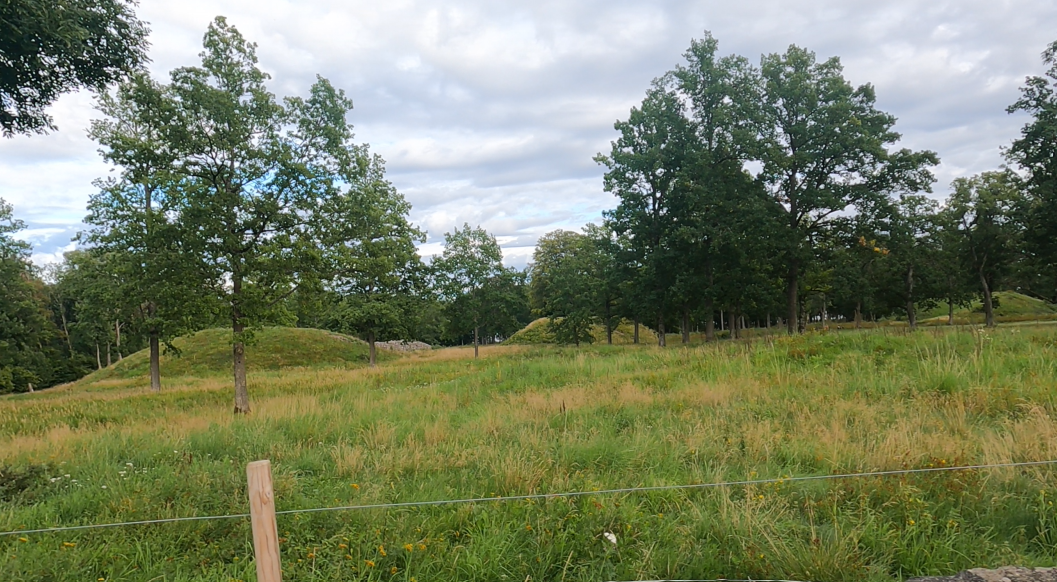
Borre, Norway: Where Viking Kings Rest and Midgardsblot Comes Alive
Share
Midgardsblot and the History of its Sacred Location
Every August, thousands of people gather at Borre, Norway, for the world-renowned Midgardsblot Viking Festival. Set against the backdrop of one of Northern Europe’s most impressive Viking burial grounds, the location is more than a festival site, it is sacred land, steeped in history, legend, and Norse religion. To walk among the mounds of Borre is to walk where Viking kings were buried, where sagas were born, and where the echoes of ancient rituals still seem to linger.
The Royal Mounds of Borre
At the heart of Borre National Park lies a sprawling cemetery of monumental burial mounds dating from the Merovingian period (c. 600 AD) through the Viking Age. Some of these mounds are over 45 meters across and six meters high, making them the largest Viking burial mounds in Northern Europe. Positioned along the Oslofjord, these mounds served as unmistakable markers of dynastic power, giant earthen monuments visible to anyone sailing past.
Archaeologists have discovered that new mounds were raised at Borre across generations, and some older ones were even reused in later centuries. DNA testing shows that the people buried here belonged to several elite families, making Borre less a family cemetery and more a royal necropolis, where ambitious chieftains and petty kings claimed their place among the honored dead.
The First Viking Ship Burial
In 1852, workmen stumbled upon what would become the first Viking ship burial ever discovered. Though the wooden ship itself had rotted away, its outline and rivets revealed a vessel around 20 meters long. Inside were the cremated remains of a man and woman, accompanied by lavish grave goods: sacrificed horses and a dog, a spinning wheel, weapons, harness mounts, and gilded ornaments.
These finds gave birth to what scholars now call the Borre style of Viking art, intricate interlacing knots and gripping beast motifs that spread across the Viking world. From Russia to England, artifacts bearing this style can be traced back to the influence of Borre’s elite.
A Viking Power Center: Halls and Harbors
Borre was more than a graveyard, it was a royal seat of power. Ground-penetrating radar surveys have revealed the outlines of massive Viking feasting halls, the largest up to 60 meters long. Such halls would have been the settings for political councils, sacred rituals, and legendary feasts. A reconstructed longhouse now stands at the Midgard Viking Centre, offering visitors a glimpse of how Viking nobility lived and ruled.
Equally important was Borre’s harbor. Evidence shows that Viking ships once docked here, making it a hub for trade, raiding expeditions, and diplomacy. Together, the harbor, halls, and burial mounds make Borre one of the most significant Viking Age power centers in Scandinavia.
Legends of the Yngling Kings
According to the medieval historian Snorri Sturluson in the Heimskringla, Borre was the burial place of the Yngling dynasty, a line of kings who traced their ancestry to the god Freyr. The skaldic poem Ynglingatal even states that a king named Halfdan died and was buried at Borre. These legends cast Borre as the Norwegian counterpart to Uppsala in Sweden, royal ground where kings were laid to rest in monumental mounds, binding their rule to divine ancestry.
Pagan Rituals and Restless Spirits
The mounds of Borre were not silent tombs. Archaeological evidence of haugbrott—the breaking open of mounds—suggests that later Vikings returned to these graves to retrieve sacred heirlooms, claim the power of their ancestors, or practice necromancy. Norse sagas often tell of restless spirits, or draugr, that haunted burial sites, and folklore long associated the Borre mounds with troublesome spirits. In this way, Borre was both a place of reverence and fear, where the line between the living and the dead was thin.
Borre Today: Midgardsblot and Living Tradition
Today, Borre is not only a protected archaeological site but also the home of Midgardsblot, one of the world’s most celebrated Viking and metal music festivals. Each year, modern seekers of heritage, spirituality, and culture gather here, dancing in the shadow of the mounds, feasting in reconstructed halls, and honoring the Norse traditions that once thrived on these very grounds.
For anyone visiting Norway, Borre and Midgardsblot offer a rare chance to stand where Viking kings were buried, where Norse religion was practiced, and where living tradition continues to thrive. Few places in Scandinavia unite past and present so powerfully.
